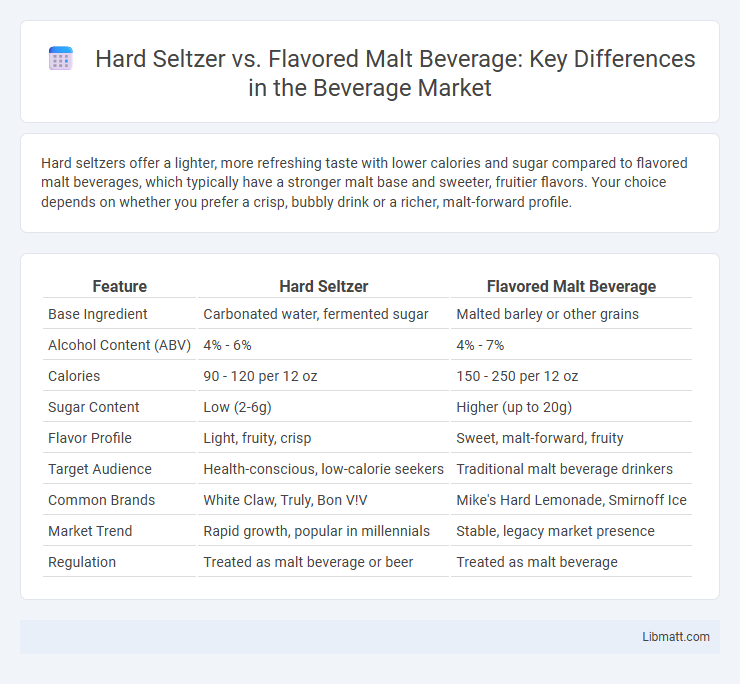Hard seltzers offer a lighter, more refreshing taste with lower calories and sugar compared to flavored malt beverages, which typically have a stronger malt base and sweeter, fruitier flavors. Your choice depends on whether you prefer a crisp, bubbly drink or a richer, malt-forward profile.
Table of Comparison
| Feature | Hard Seltzer | Flavored Malt Beverage |
|---|---|---|
| Base Ingredient | Carbonated water, fermented sugar | Malted barley or other grains |
| Alcohol Content (ABV) | 4% - 6% | 4% - 7% |
| Calories | 90 - 120 per 12 oz | 150 - 250 per 12 oz |
| Sugar Content | Low (2-6g) | Higher (up to 20g) |
| Flavor Profile | Light, fruity, crisp | Sweet, malt-forward, fruity |
| Target Audience | Health-conscious, low-calorie seekers | Traditional malt beverage drinkers |
| Common Brands | White Claw, Truly, Bon V!V | Mike's Hard Lemonade, Smirnoff Ice |
| Market Trend | Rapid growth, popular in millennials | Stable, legacy market presence |
| Regulation | Treated as malt beverage or beer | Treated as malt beverage |
Introduction to Hard Seltzer and Flavored Malt Beverages
Hard seltzers are sparkling water infused with alcohol, typically made from fermented cane sugar or malted barley, offering a low-calorie, low-carb alternative to traditional alcoholic drinks. Flavored malt beverages (FMBs) are brewed from malted barley and flavored with fruit or other natural flavors, often containing higher sugar and calorie content than hard seltzers. Understanding the differences between hard seltzer and flavored malt beverages can help you choose a refreshing option that aligns with your taste preferences and dietary goals.
Key Ingredients and Production Processes
Hard seltzers primarily consist of carbonated water, alcohol derived from fermented sugar, and natural fruit flavors, with a focus on a clean, crisp taste. Flavored malt beverages use malted barley as the base fermentable sugar, combined with added flavorings and sometimes sweeteners, resulting in a sweeter profile. Your choice may depend on whether you prefer the light, low-calorie nature of hard seltzers or the maltier, richer flavor of flavored malt beverages.
Alcohol Content Comparison
Hard seltzers typically contain 4-6% alcohol by volume (ABV), offering a lighter alternative compared to flavored malt beverages, which often range from 5-7% ABV. Your choice may depend on preference for lower or slightly higher alcohol content, as flavored malt beverages generally deliver a stronger kick. Understanding these differences helps you manage alcohol intake while enjoying a flavored drink.
Flavor Profiles and Varieties
Hard seltzers typically feature light, crisp flavors such as citrus, berry, and tropical fruit, emphasizing refreshment with a subtle sweetness and effervescence. Flavored malt beverages offer a broader range of robust, sweeter profiles including cola, lemonade, and dessert-inspired varieties, often with a malt-forward base adding complexity. Both categories continuously expand their flavor portfolios to cater to diverse consumer preferences, with hard seltzers leaning toward low-calorie, natural taste experiences while flavored malt beverages embrace bold, indulgent flavor innovations.
Calorie, Sugar, and Nutritional Differences
Hard seltzers typically contain 90-100 calories per 12-ounce serving with 1-2 grams of sugar, making them a lower-calorie and lower-sugar option compared to flavored malt beverages, which often have 150-200 calories and 10-20 grams of sugar per serving. The nutritional profile of hard seltzers is usually simpler, containing fewer carbohydrates and no artificial flavorings or colorings, whereas flavored malt beverages may include added sugars, artificial ingredients, and higher carbohydrate content. Consumers seeking lighter alcoholic options with fewer calories and sugars often prefer hard seltzers for their minimal nutritional impact.
Market Trends and Consumer Preferences
Hard seltzers have surged in popularity due to their lower calorie count and perceived health benefits, capturing a significant share of the beverage alcohol market. Flavored malt beverages maintain steady demand by appealing to consumers seeking sweeter, fruitier taste profiles and nostalgic brand experiences. Your choice may depend on preferences for calorie-conscious options versus more diverse, indulgent flavor varieties.
Brand Leaders in Each Category
White Claw and Truly dominate the hard seltzer market, known for their crisp flavors and low-calorie options. In the flavored malt beverage category, brands like Mike's Hard Lemonade and Smirnoff Ice lead with a sweeter, more robust taste profile. Choosing between these brands depends on Your preference for lighter, refreshing drinks or bolder malt flavors.
Health Considerations and Perceptions
Hard seltzers typically contain fewer calories, less sugar, and lower alcohol by volume (ABV) compared to flavored malt beverages, making them a popular choice for health-conscious consumers. Flavored malt beverages often include added sugars and artificial ingredients, which may contribute to higher caloric intake and negative health perceptions. Health experts frequently recommend hard seltzers as a lighter option due to their simpler ingredient profiles and reduced impact on blood sugar levels.
Price Points and Accessibility
Hard seltzers typically range from $8 to $12 per six-pack, offering a moderately higher price point compared to flavored malt beverages, which often cost between $6 and $10 for the same quantity. Flavored malt beverages benefit from wider availability in convenience stores and supermarkets, making them more accessible in rural and lower-income areas. Market trends show that hard seltzers dominate urban and health-conscious demographics despite their premium pricing.
Which One Should You Choose?
Hard seltzers offer a lighter, lower-calorie option with a clean taste primarily derived from fermented cane sugar or malt base, appealing to those seeking refreshing, lower-alcohol beverages. Flavored malt beverages often have a higher alcohol content and a sweeter, more robust flavor profile due to malted barley and added flavorings, making them suitable for consumers who prefer bold, sweeter drinks. Choose hard seltzer for a crisp, health-conscious option, or select flavored malt beverages for richer taste and higher alcohol strength.
Hard seltzer vs flavored malt beverage Infographic

 libmatt.com
libmatt.com